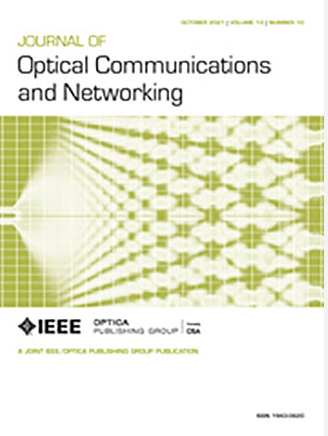Edge coloring bipartite multigraphs for dynamically configuring optical switches
IF 4.3
2区 计算机科学
Q1 COMPUTER SCIENCE, HARDWARE & ARCHITECTURE
引用次数: 0
Abstract
Multi-chip graphics processing units (GPUs) interconnected by a photonic network-on-wafer are a promising technology to further increase the performance of GPUs. The network control algorithm managing dynamic bandwidth allocation (DBA) in this network needs to execute very frequently so that resources can be optimally used. This algorithm relies on edge coloring bipartite multigraphs to translate inter-chip bandwidth demands into updated routing tables for the GPU chips and optical switches in the network. In this work, we design fast edge coloring algorithms, both approximate and exact, for bipartite multigraphs. These algorithms are tailored to the high edge multiplicities of the multigraphs in this research. The runtimes are optimized by using efficient data structures and introducing pre- and post-processing. These new algorithms are up to动态配置光开关的边缘着色二部多图
利用光子片上网络实现多芯片图形处理单元(gpu)互连是进一步提高gpu性能的一种有前途的技术。该网络中管理动态带宽分配(DBA)的网络控制算法需要非常频繁地执行,以便最优地利用资源。该算法依靠边缘着色二部多图将芯片间带宽需求转换为网络中GPU芯片和光交换机的更新路由表。在这项工作中,我们设计了二部多图的快速边缘着色算法,包括近似和精确。这些算法是针对本研究中多图的高边缘多重度而量身定制的。通过使用高效的数据结构和引入预处理和后处理来优化运行时。这些新算法比最先进的基线算法快100倍。新的模拟表明,在如此低的重新配置周期下,与具有相同带宽的静态网络相比,DBA有可能将高流量GPU工作负载的性能提高一倍。
本文章由计算机程序翻译,如有差异,请以英文原文为准。
求助全文
约1分钟内获得全文
求助全文
来源期刊
CiteScore
9.40
自引率
16.00%
发文量
104
审稿时长
4 months
期刊介绍:
The scope of the Journal includes advances in the state-of-the-art of optical networking science, technology, and engineering. Both theoretical contributions (including new techniques, concepts, analyses, and economic studies) and practical contributions (including optical networking experiments, prototypes, and new applications) are encouraged. Subareas of interest include the architecture and design of optical networks, optical network survivability and security, software-defined optical networking, elastic optical networks, data and control plane advances, network management related innovation, and optical access networks. Enabling technologies and their applications are suitable topics only if the results are shown to directly impact optical networking beyond simple point-to-point networks.

 求助内容:
求助内容: 应助结果提醒方式:
应助结果提醒方式:


